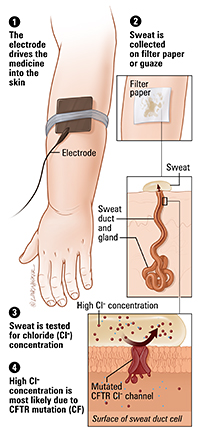Cystic fibrosis (CF) — also known as mucoviscidosis — is a genetic disorder that mostly affects the lungs but also the pancreas, liver, kidneys and intestines. Long-term issues include difficulty breathing and coughing up sputum as a result of frequent lung infections. Other symptoms include sinus infections, poor growth, fatty stool, clubbing of the finger and toes, and infertility in males among others. Due to defective chloride channels (CFTR), the concentration of chloride (Cl) in sweat is elevated in individuals with CF. As a first screening for CF, a sweat test can be used to measure the concentration of chloride that is excreted in sweat.

To perform the test, sweating is induced by pilocarpine1 iontophoresis2. At the test site, an electrode is placed over gauze containing pilocarpine and electrolyte solution that will not interfere with the sodium and chloride measurement. A second electrode (without pilocarpine) will be placed at another site and a mild electric current will draw the pilocarpine into the skin where it stimulates the sweat glands.
The test site is carefully cleaned and dried, then a piece of preweighed filter paper is placed over the test site and covered with parafilm to prevent evaporation. Specialized collection devices may also be used. Sweat is collected for 30 minutes. The filter paper is retrieved and weighed to determine the weight of sweat collected. Several laboratory methods are then used to determine the sodium and chloride concentrations.
Standardized reference concentrations are used for the interpretation of the sweat test. For infants up to and including 6 months of age, a chloride level of
-
less than or equal to 29 millimol per liter (mmol/L): CF is very unlikely
-
30 – 59 mmol/L: CF is possible
-
greater than or equal to 60 mmol/L: CF is likely
For people older than 6 months of age, a chloride level of
-
less than or equal to 39 mmol/L: CF is very unlikely
-
40 – 59 mmol/L: CF is possible
-
greater than or equal to 60 mmol/L: CF is likely
Two reliable positive results on two separate days is diagnostic for CF. Because of the existence of milder variants, borderline or even near-borderline negative results may be used to diagnose CF. Clinical presentation, family history and patient age must be considered to interpret the results. Highly discordant sodium and chloride values may indicate technical errors.
Input
Two integers, each on a separate line. The first integer represents the age of the patient, expressed in months. The second integer represents the chloride levels measured in the skin of the patient, expressed in mmol/L.
Output
The diagnosis for CF based on the input data. This diagnosis must be formatted as CF is diagnosis, where the cursive fragment must be filled up with very unlikely, possible or likely based on the reference concentrations given in the introduction.
Example
Input:
6
35Output:
CF is possibleExample
Input:
9
63Output:
CF is likely